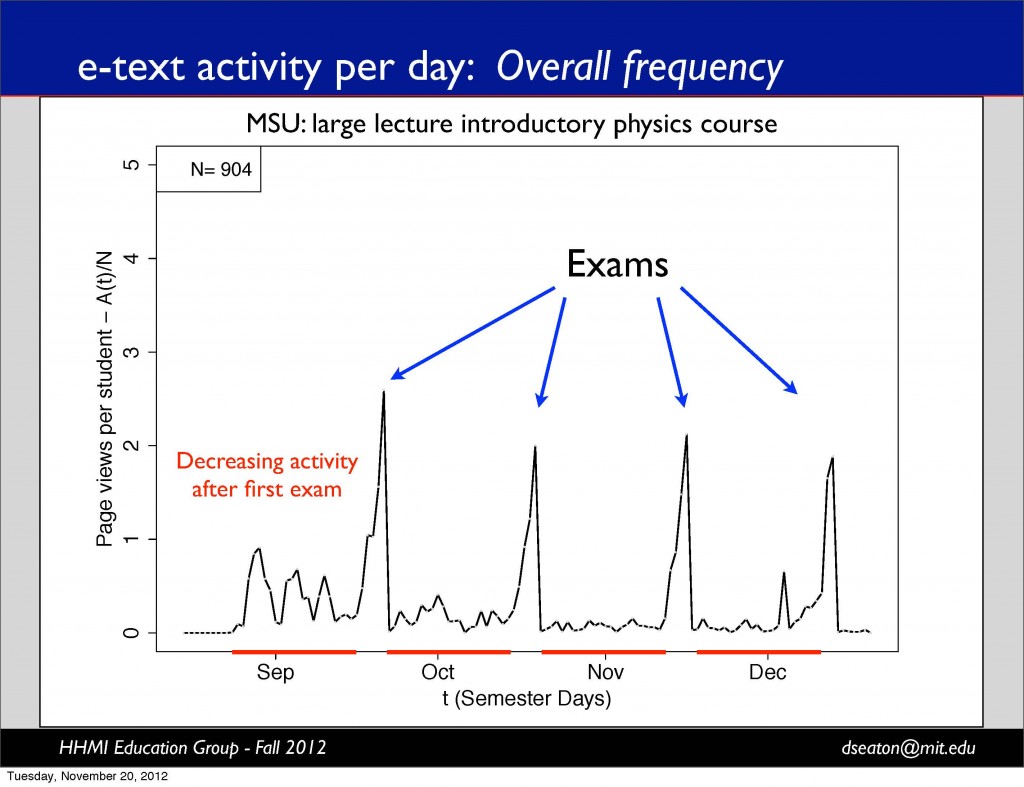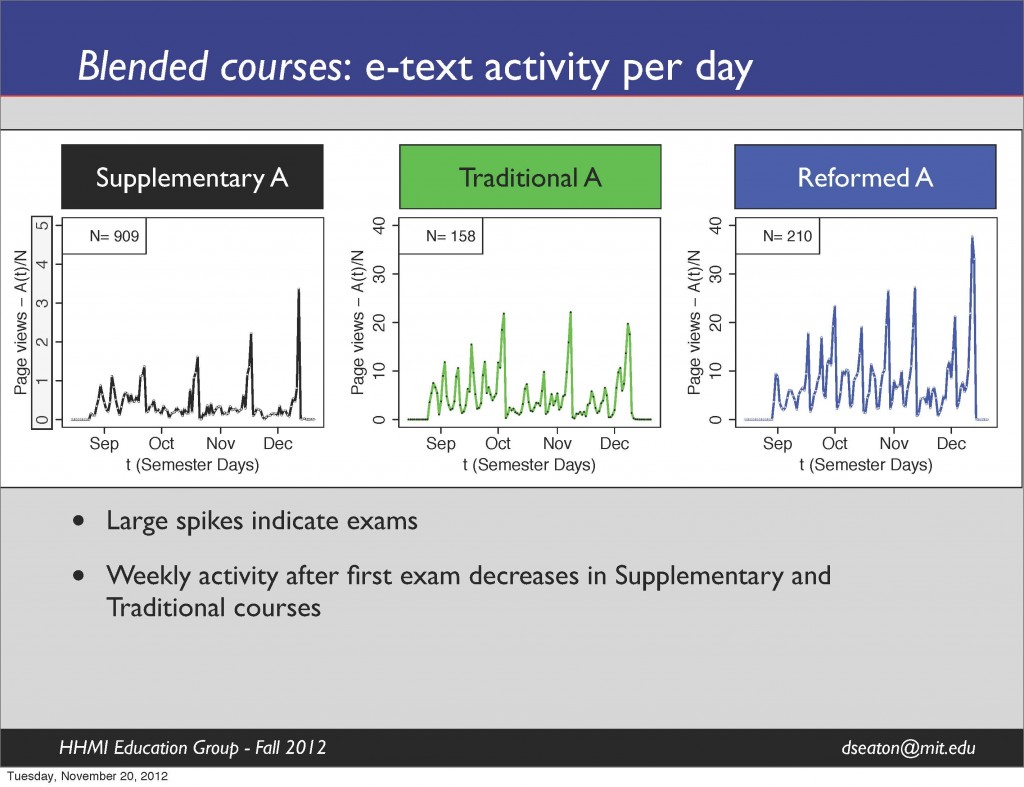 Dr. Daniel Seaton
Dr. Daniel Seaton
Title: Do students read textbooks? E-text use in blended and online introductory physics courses
Group Meeting Date & Time: Wednesday, November 14, 2012 @ 1:30 pm
View the slides from the group meeting
During his recent group meeting, entitled “Do students read textbooks? E-text use in blended and online introductory physics courses”, Dr. Daniel Seaton gave us his expert insight on student behavior regarding online textbooks.
Dr. Seaton is a postdoctoral associate in Professor Dave Pritchard’s RELATE (Research in Learning, Assessment and Tutoring Effectively) physics education group at MIT. The RELATE group’s work focuses on applying data mining, learning analytics and psychometrics to a variety of educational data sets with the main purpose to affect content development and teaching.
The majority of large introductory physics courses utilize course management systems (CMS), such as LON-CAPA and edX, to disseminate information regarding problems and course material to all students in the course. One advantage to using such a course management system is the ability to collect data regarding student behavior online. For example, Professor Pritchard’s Mechanics course in the LON-CAPA CMS contains 14 units and more than 1000 multi-level problems. Professor Gerd Kortemeyer’s group meeting earlier this year discussed the LON-CAPA course management system, which has one of the largest content repositories in the world with approximately 400,000 resources. While Professor Pritchard’s group has used LON-CAPA as a CMS for MIT Physics Course 8.011 and an IAP Mechanics review course, they are currently migrating their resources onto the edX platform.

Figure 1. E-text activity in online course. E-text behavior demonstrated very limited e-text usage, with spikes in access immediately prior to exams, in low-structure courses with supplemental e-text materials.
Dr. Seaton’s research focuses on whether a better understanding of student behavior in online courses can promote more effective learning outcomes for students. In particular, Dr. Seaton focused on the effectiveness of textbook materials in courses. Past research on textbook use has relied upon student surveys focused on small data sets with unclear results. Course management systems offer a wealth of data that accurately reflects student behavior regarding e-text reading. Dr. Seaton set out to better understand how students utilize e-text materials that are available to them online and how course structure affects student behavior. Although this group meeting focused on student behavior, Dr. Seaton would ultimately like to connect these data to student learning.
Previous research on the effect of course structure has demonstrated that course structure does affect students’ attitudes and perceptions about learning in a course. A more highly structured course with weekly activities has been shown to increase performance and reduce the learning achievement gap in introductory biology courses (Freeman). As a result, Dr. Seaton kept course structure in mind when analyzing the e-text usage in three different courses: 1) Mechanics Reform Course at MIT, 2) Multimedia Physics at Michigan State University and 3) Electronic Circuits Course at MIT (inaugural edX course, 6.002x). While all three have homework assignments, discussion forums and e-text materials, all three courses differ in their course structure. The Mechanics Reform course utilizes best teaching practices and is designed to be a review course, the Multimedia Physics course is primarily a traditional course that has been imported into an online course structure, and the edX pilot course contains a complete version of the traditional textbook into an e-text format.
Using data from all three of these courses, Dr. Seaton measured three aspects of e-text usage: 1) overall frequency of access, 2) number of unique accesses, and 3) total time spent reading e-text material. Retrieving the data from the server logs is quite a feat and would require a group meeting devoted to this topic by itself!
Dr. Seaton first analyzed the Introductory Physics course at MSU. Since the course has almost 900 students, Dr. Seaton was thrilled to have such a large population of data to analyze. Analyzing the daily usage of e-text materials clearly demonstrated that e-text usage peaked immediately prior to the exams in the course. Additionally, while students read the e-text material prior to the first exam, e-text reading dropped off dramatically following the first exam (Figure 1). Ultimately, Dr. Seaton found that e-text were utilized at an incredibly low rate with the total amount of time spent reading them to be less than 1 hour for the entire course!

Figure 2. E-text usage across courses. Students utilize e-text materials more in "Reformed" courses, compared to "Supplemental" and "Traditional" courses.
Dr. Seaton then analyzed e-text behavior in two blended (both traditional and online) courses: Michigan State University’s Multi-Media Physics course and MIT RELATE’s Mechanics Reform course. Given that the MSU course has a wealth of data spanning many years and that the course has been redefined during this period of time, Dr. Seaton divided the course into 3 categories: 1) Supplemental, in which the e-text material was secondary to the traditional textbook, 2) Traditional, in which the e-text material was the primary textbook but the course followed a low-structure format, and 3) Reformed, in which the e-text material was the primary textbook and the course followed a highly structured format. MIT’s Mechanics Reform course is categorized as Reformed since the e-text material serves as the primary textbook and the course follows a high-structure format.
Upon analyzing the e-text usage, Dr. Seaton noticed a sharp increase in students’ daily activity of e-text materials in the Reformed courses. While there are still large spikes of activity immediately prior to exams, the number of spikes increased due to more frequent exams. While students typically exhibited a decrease in e-text reading in Supplemental and Traditional courses, there was no such decline in Reformed course structures. Interestingly, e-text usage was the greatest in courses with a Reformed course structure (Figure 2). In the Reformed courses, on average each student spent approximately 12 hours reading e-text materials during the course, which is a far cry from less than one hour per student in the first course Dr. Seaton analyzed!
Following this positive data, Dr. Seaton turned to the analysis of e-text usage in the inaugural edX course, 6.002x. This Circuits & Electronics course followed a less-structured course format in which the students only completed one exam and one final and the e-text material served as secondary reference material. The e-text material usage data indicates that students rarely utilized the e-text, in a similar fashion to other courses that utilized the e-text materials in a supplemental fashion.
The analysis of e-text materials has been incredibly enlightening to inform us of how students utilize the e-text materials. It is quite clear that course structure dictates student behavior surrounding e-texts. While students in Reformed courses utilize e-text materials to a greater extent, Dr. Seaton will now determine whether this has a direct effect on greater student learning. In the future, Dr. Seaton will analyze student behaviors, and their affect on student learning, in several course components, including: homework, lecture videos, laboratory materials, tutorials, and the discussion forum. The advent on MOOC’s, massively open online courses, opens doors to even more data regarding student behavior in courses and the benefits on student learning.



